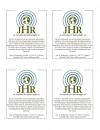Article #6 from Volume 1, Issue 1: Homelessness
“Internally Displaced Persons: The Scope of Their Human Rights Protections”
Rachel Proefke
We see their photos in newspapers and their faces momentarily plastered on TV – emaciated figures which could sooner be skeletons than humans trekking across countries and sticking arms out of barbed-wire-enclosed refugee camps. When we see them, they strike the chord of our human ethos and persuade us to consider taking action.
However, whether we take action or just think about how terrible it is, refugees alone are not the only significant aftershock of civil war, poor natural conditions, or mass persecution. The problem of internally displaced persons (IDPs) is just as notable; perhaps even more so as they do not as easily garner the same protections bequeathed to refugees by the bevy of international agreements that form the legal framework for those who cannot return to their war-shaken homelands.
We are often presented with the stories of refugees and their harrowing trials, but sometimes IDPs – at least on an individual and impacting level – are neglected. Often IDPs are solely represented through the brief statistical information of their relative numbers and do not gain the access to the spotlight that they deserve.
 By remaining within sovereign borders, they remain within the repressive political structure that forced them to leave their homes in the first place. Perhaps with increasing significance, they will gain an increasing voice.
By remaining within sovereign borders, they remain within the repressive political structure that forced them to leave their homes in the first place. Perhaps with increasing significance, they will gain an increasing voice.
With civil war and genocide raging in Sudan, masses of people have been and are being forced from their homes in the south.
Some of these people will seek refuge in neighboring nations, such as Egypt, Chad, Ethiopia, and Kenya.
Others, for whom this is not a feasible option, will be trapped within the borders of Sudan, adding to the massive numbers of internationally displaced persons. Some sources report that this figure could be as high as 4 million within Sudan itself – one of the largest concentrations of IDPs in the world.
Despite the practical concerns of such an exodus and the issues that arise when mass groups of people are forced to subsist in whatever region of refuge they may find, there are also the legal concerns of such an increasingly prominent situation.
They entail the extent to which IDPs qualify for special protection and exactly what human rights protections these groups are entitled to. As these migrants do not qualify for refugee status, they are mostly entitled to the general protections of the international human rights framework – as well as such special treaties as their nation is a party to.
In essence, their special situation denotes no special protection, such as that conferred to women, children, and refugees.
In addition to the general human rights provisions bestowed by multiple international human rights instruments, the United Nations (UN) – under the direction and suggestion of the UN Secretary-General’s Special Representative on IDPs – adopted The Guiding Principles on Internal Displacement in 1998. This document relates existing human rights laws to IDPs, and seeks to extend refugee protections to them. Despite the perceived international support for this document, there is no greater accountability or enforceable mechanisms as the document is not legally binding.
The state is responsible for enforcing human rights, and it agrees with the documents that detail them and offer protective mechanisms to their maintenance; with greater and more extensive rights come greater bargaining power, a more tangible sense of security, and more extensive accountability.
As IDPs gain greater numbers, their plight will gain a greater amount of attention, which will bring with it the construction of new mechanisms of protection for this neglected group.
Labels: homelessness, human rights, newsletter, rachel proefke, university of washington, uwjhr







